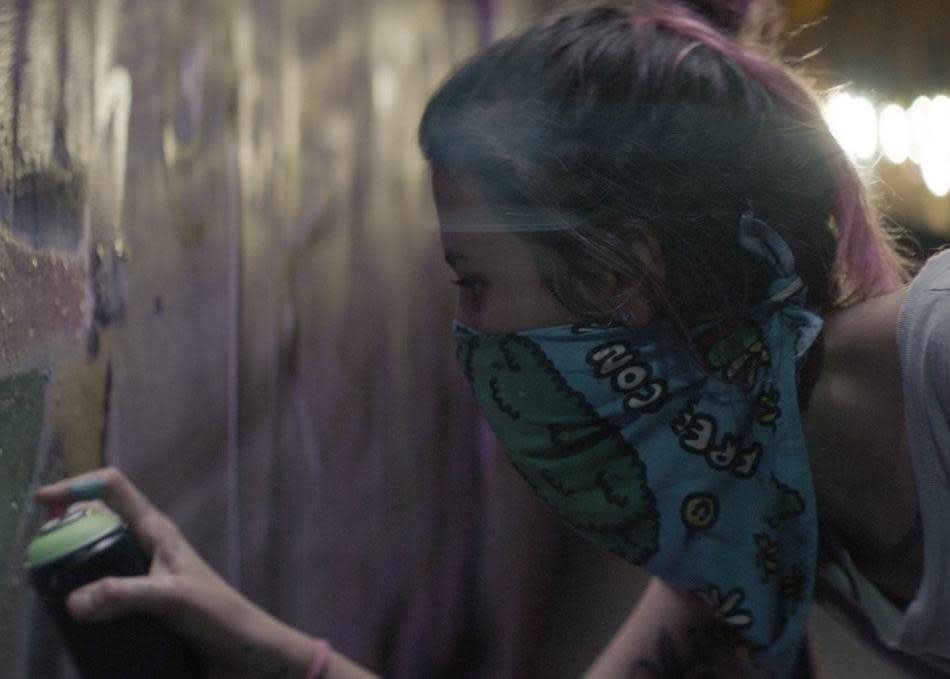Film Review: ‘Days of the Whale’

For all the peril that darkens its fringes, there’s an indomitable youthful exuberance that thrums through Catalina Arroyave Restrepo’s debut feature “Days of the Whale.” It makes the slight, and somewhat familiar, small-scale story, following a few days in the lives of a pair of Medellín-based graffiti artists, feel fresh enough as to be wet to the touch — a neon-colorful, if not hugely deep, manifesto of optimistic defiance spray-stenciled on a newly white-washed wall.
It’s this unmistakable energy and unconcealed filmmaking glee, rather than any particularly strong narrative instinct that marks Arroyave as one to watch. And as a calling card, “Days of the Whale” has already performed well, garnering the writer-director a special recognition in the CherryPicks Female First Feature category at SXSW, following stints at the Cartagena and Tallinn Black Nights film festivals. And in providing such a markedly lively contrast to her countrywoman Laura Mora’s grittier, dourer debut “Killing Jesus,” as well as to the epic, cinematic sprawl of the Cristina Gallego co-directed “Birds of Passage,” it suggests a nascent Colombian filmmaking resurgence that is not only diverse in terms of gender, but in style and approach.
Related stories
SXSW Film Review: 'J.R. 'Bob' Dobbs and the Church of the SubGenius'
SXSW Film Review: 'Come as You Are'
Cris, played by casually stunning newcomer Laura Tobón, is a young street artist from a middle-class background, who lives with her father and his snippy new wife. Her mother, glimpsed in a couple of Skype calls, is a well-respected journalist who had to flee Medellín following some coverage that put her in the crosshairs of the local criminal element (it’s one of the film’s refreshing aspects that while crime and violence are omnipresent threats, Medellín’s most infamous erstwhile resident, Pablo Escobar, is never mentioned by name.)
Lightly tattooed and sporting scraggly pink-ombre highlights, Cris hangs out with fellow artist Simon (David Escallón). But what begins as a platonic relationship based on clandestine late-night painting sessions soon blossoms into more. Otherwise drama is in short supply in the first act, but the chemistry between the pair makes it a pleasure to watch, and as Cris and Simon nuzzle shyly closer, the film compels as a gentle portrait of the blissed-out uncertainty of new love — that heady period when you just can’t stop smiling at each other.
New notes are soon introduced, however. Cris and Simon are part of an artists’ collective run by Lucas (Carlos Fonnegra) who is coming to the malevolent attention of a local street gang running a protection racket. The slightly reckless Simon, explicitly from a less well-off background than the cautious Cris, used to run with these guys, and overestimates the level to which that gives him ongoing immunity. “We’re not in fifth grade anymore,” he is reminded by one of the gang’s enforcers, but when a threatening slogan appears on the wall opposite the collective’s HQ (colloquially translated to “snitches get stitches”), Simon is the first to advocate that they erase it. This relatively low-stakes dilemma forms the chief dramatic pivot point of the rest of the film’s brisk running time, as Cris wavers and then resolves to cover the wall in a large, psychedelic image of a whale — the film’s recurrent but slightly underdeveloped central metaphor.
Where the story threatens to falter, David Correa’s quick handheld camerawork urges it along, not so much painting a picture as sketching it out, in impatient, pressurized bursts of color and closeup, that rattle, fizz, and drip like spray paint from a can. And Victor Acevedo’s music, punctuated with bright, popping splashes of salsa, clubby remixes, and hard-edged Colombian hip-hop gives the film’s hip urban vibe its perfect sonic dimension.
If there is an issue with this otherwise confident, good-looking debut, it’s that the unmistakably upbeat filmmaking is slightly at odds with the precarious situation it is portraying. This is exacerbated by the foregrounding of Cris, insistently tugged into the foreground by Correa’s mobile camera, despite her arc being less inherently dramatic than that of many around her. There is perhaps an element of solipsism there, but if so, it’s a pretty accurate embodiment of the self-absorption of the young romantic. And that is really where the promising Arroyave’s interests seem to lie, not with any hard-hitting exposé of the seedy underbelly of cartel-blighted Medellín (and thank heavens, because we already have enough of those) but with the simple and universal expression of being young, creative, and, despite the dangers that may lurk around the next graffiti-tagged corner, irrepressibly alive.
Sign up for Variety’s Newsletter. For the latest news, follow us on Facebook, Twitter, and Instagram.

